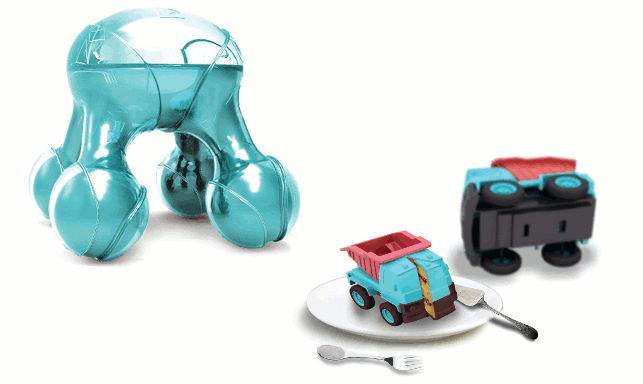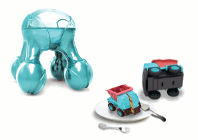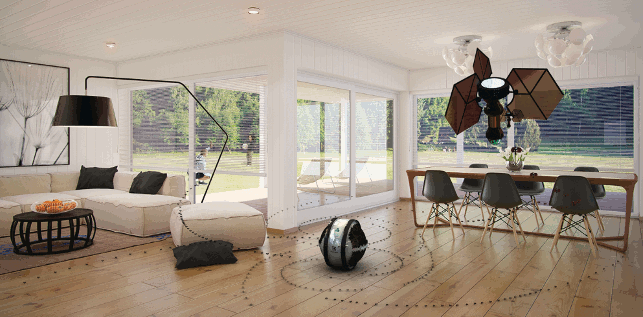Bees Knees
We all long for mystical fairies to tidy the house while we’re out, which is something not lost on Colombian designer Adrian Perez Zapata, this year’s winner of Electrolux Design Lab, an annual student design competition.

His idea comes from a magical scene he imagines in which hundreds of fairies delicately clean each surface in the home.
Subsequent to the advances in micro robots, and studying swarm behaviour of bees, Zapata has designed a futuristic cleaning concept.
“My concept Mab only requires a short initial configuration to function autonomously,” says Zapata. “So you could arrive home and see a swarm of mini-robots roaming around cleaning independently. This means you could sit back and relax, as you observe with great astonishment the little Mab ‘fairies’ working their magic autonomously.”
Yet the design is more than just whimsy – already Harvard School of Engineering and Applied Sciences’ RoboBee is undergoing further development [DEVELOP3D June], and swarm behaviour software is advancing through several research bodies.
Each mini-robot transmits information from the environment and just as a swarm of bees acts as one organism, the collective brain interprets the context at all times.
Zapata used Rhino 5 to produce the 3D model of the robots and their spherical docking ‘hive’, which also doubles as a bin into which any collected dirt is disposed.
The concept was then rendered in Brazil 2.0 within Rhino. Advances in 3D printing would enable the manufacture of such precise parts. These will be assembled together with the circuitry and electronics.
Although Mab might freak a few people out, most will no doubt look forward to the day when swarms of intelligent robots can pick up dust, dirt and collaboratively eject pizza boxes from our abodes.
Playing with your food
Establishing healthy habits in kids through creativity and the playful aspects of the cooking process has been happening for years.

Luiza Silva from Brazil, who came second in the contest, designed a concept that “addresses the global issue of adopting healthy lifestyles and countering chronic diseases, with inspiration from the playfulness and creativity of children.”
The Atomium is in essence a 3D printer for healthy food in the home. The user sketches a 2D design, and the food, as a molecular paste, is formed into a 3D version.
“I could find that almost every food is structured by 20 diff erent molecules,” explains Silva. “Therefore by deconstructing food into its base, the molecules, and reconstructing them in different ways, we can create a big amount of quantity and quality of flavours.”
Following research with children, and realising that food could be printed from a molecular level up, the idea developed of forming it into playful 3D shapes.
Using SolidWorks to build a 3D model and Keyshot to render it, Silva also returned back and forth to clay models.
“I focused on the product’s proportions, some mechanism to open and close the machine and interior aspects, such as: how would be the selection of ingredients and the movement of capsules inside the foot of Atomium; how and which technology apply to move them to the head; how to add ingredients in the capsules when they are empty; how to extrude the paste, etc.,” she says.
Wonder wall
With stress impacting all our lives with extended working hours, and taking our work home with us, we’re coming to realise that our homes are increasingly key to our happiness.

t’s believed that around half of our stress comes from the workplace, so creating an air of calm in the home was the key idea behind designer Jeabyun Yeon’s concept of a ‘breathing’ wall.
The concept not only manages colour and fragrance for a room, but its in-built ‘gills’ filter fresh air into the room from outside, while their movement provides a guide for breathing exercises.
Using the fish in the nearby aquarium in South Korea as influence for the concept, Yeon had the idea of removing stress via the gills, like a fish filters water.
It’s quite hard to realise from the concept images, but the structure’s interior would contain various sets of filters and vents to avoid opening up the home to the elements.
Working in Rhino 3D to design the 3D model, Yeon used the T-splines plug-in to help create various types of soft shapes.
The final 3D model was rendered in Keyshot, with additional fi nishing touches added in Adobe Photoshop.
Yeon’s creation won third prize in the Electrolux Design Lab Contest. The next step is to create a prototype wall, fi tted with all the moving parts, internal diaphragms and filters that will hopefully bring some peace and tranquillity to urban life in the future.
A look at the winning designs of this year’s Electrolux Design Lab Contest
Default






